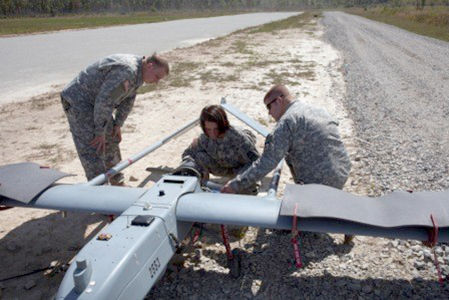New CAEST minor explores applications, misconceptions of unmanned aeronautics

A drone being examined at Camp Atterbury in Indiana, one of the test ranges of the Uunmanned Aircraft Systems Center. Photo courtesy of Ohio/Indiana UAS Center program manager Brittany Peterson.
March 1, 2015
The introduction of the unmanned aircraft systems minor opened the door to a whole new category of aeronautic education at Kent State.
The College of Applied Engineering, Sustainability and Technology first began offering the five-course minor in the fall 2014 semester. According to university enrollment data, a total of 17 students declared unmanned aircraft systems, also known as UAS, as a minor.
The minor provides students with an introduction to the design, performance, technology and operational aspects related to unmanned aircraft systems. Students also learn about UAS ground and flight operations, on-board systems, sensor characteristics, control systems and communication systems, according to the course description for the minor.
“I chose this minor because a lot of people think all unmanned aircraft systems are bad,” said Kaitlin Patterson, a sophomore air traffic control major with a UAS minor. “I kept thinking to myself, ‘What about all the good parts of these systems?’ So when I found this minor, I knew it was perfect for me, especially for air traffic control. It gives me and my career an extra little edge.”
Josh Euston, a junior air traffic control and aviation management major with a UAS minor, said he declared this minor due to the future of unmanned flight in the aeronautics industry.
“I’m getting ahead of everyone else by having this minor because not everyone can come out of college with aviation background and UAS knowledge, which could be helpful for employers in the future,” Euston said.
Charles Wentz, a part-time faculty member and former UAS test engineer for a major defense contractor, currently teaches one of the classes required for the minor.
“This minor potentially offers a tremendous career opportunity because, let’s face it, unmanned aircraft systems are becoming a fact of life,” Wentz said.
Current UAS applications include surveillance, military operations, natural disaster observations, search and rescue efforts, agricultural uses and even public service assistance, Wentz said.
One of the most common UAS misconceptions involves interchanging the term with drones. Wentz’s students learn the important difference between the two in the first introductory course for the minor.
“I feel like the word ‘drone’ is a derogatory term used towards unmanned aircrafts, which is why people always think of them as something negative,” Euston said.
Wentz said in the early 1900s, drones carrying bombs were led by a manned aircraft to a target, upon which the pilot would bail out and leave the drone to hit the target. Drones were also commonly used as target practice for military training purposes.
“Unmanned aircraft systems imply a technically sophisticated vehicle, which is one that can do more than just be radio controlled,” Wentz said. “A UAS can be preprogrammed to fly a navigational route, which can be changed or controlled by a person at a communication station. It also carries sensors and cameras to do specific jobs that basically amount to a sophisticated airplane without a pilot.”
“Drones are a thing of the past,” Wentz said. “The term is archaic with respect to an unmanned aircraft system, so it’s not even appropriate anymore. And this misconception most definitely stems from the media always referring to unmanned aircraft systems as drones.”
Wentz and his students both agree about the possibilities for UAS use in the foreseeable future.
“The future of unmanned aircraft systems is a lot closer than we think it is,” said Kyle Weaver, a junior aeronautical systems engineering technology major with a UAS minor. “It takes just one person with a good idea to show everyone what a UAS can really do.”
Contact Julianne Calapa at [email protected].











